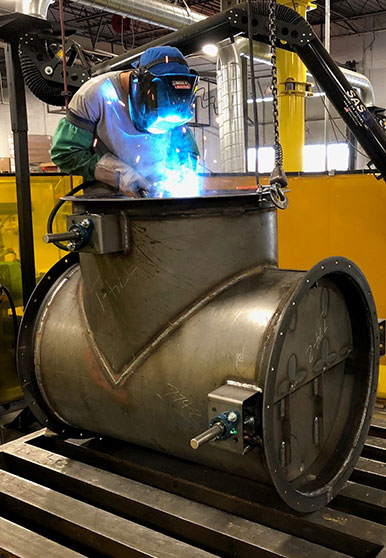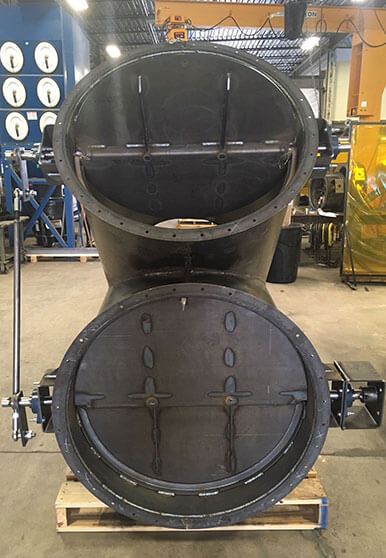
Diverter & Tee Dampers
Tee dampers and diverter dampers from Kelair are available in the classic "T" formation as well as a variety of possible configurations.
Download our BrochureKelair Dampers Brochure

A pre-assembled Diverter or Tee Damper has many advantages
A Diverter or Tee damper can be a very simple tool with 1 purpose: to divert the flow of air or gas within a system in another direction.
Industrial diverter dampers and tee dampers are typically arranged as a dual damper that resembles a Pipe-T, however, it can also be configured at 45 degrees or as a “Pant Leg” version. The 2 openings or outlets are mechanically linked so that when one is opened, the other is closed.
The use of one actuator with a slave linkage saves cost and assures simultaneous operation of both dampers in the assembly. Spring-assisted actuators can be utilized to provide a predetermined fail position of the damper vanes if power is lost. Open/closed auxiliary limit switches are also available.
Tee/Diverters can also perform the trifecta of damper functions: modulate, divert and isolate air or gas flow. This is done by adding a modulation actuator to allow diversion to multiple outlets. In fact, Kelair can manufacture a 3 or 4-way diverter damper that has up to 4 outlets, that runs all 3 of these operations: modulation, diversion, and isolation.
*Operational testing and calibrating are completed at the factory prior to installation.


Product Features & Specifications
- Sizes: 10″ to 48″
- Process Temperature: up to 1800° F
- Configurations: round, square, & rectangular
- Construction: S.S. or painted C.S. (others available upon request)
- Shutoff: up to 99%
- Seal Options: tadpole, metal seat, swing-thru; control & balancing
- Actuation: manual, electric & pneumatic (spring return and failsafe available)
- Modulation: open/closed or modulating
- Pressure: up to 1 PSI & 4000 FPM process air (higher available upon request)
- Ball bearings and shaft packing glands standard


Commonly Asked Questions About Diverter & Tee Dampers
- What are some of the most common applications for diverter and tee dampers?
- How are bearings inspected on the diverter and tee dampers?
- What is the recommended inspection frequency for the shaft of diverter dampers?
- What is the minimum information I need to get a quote on a damper?
- Can you custom design a damper for me?

